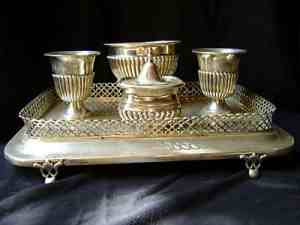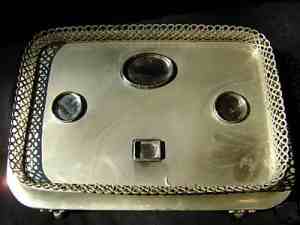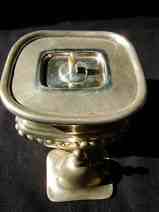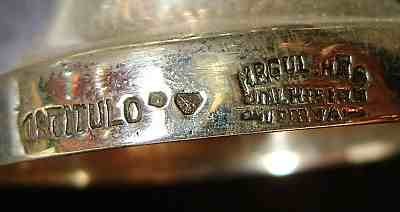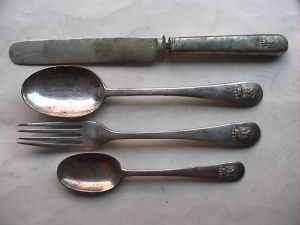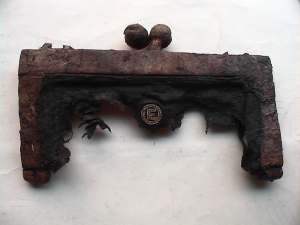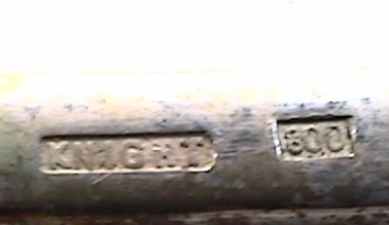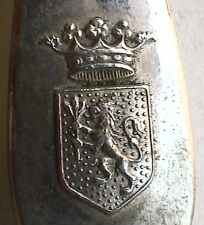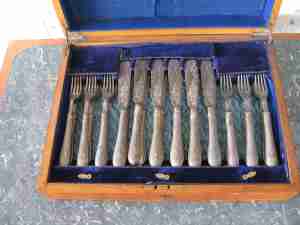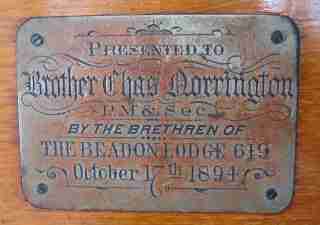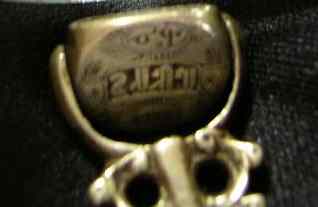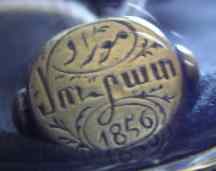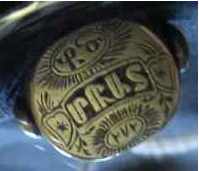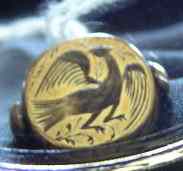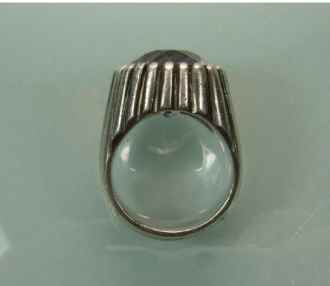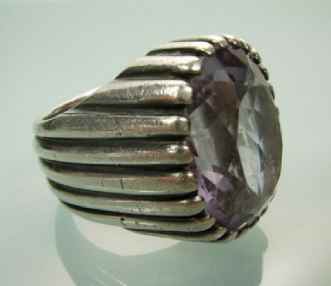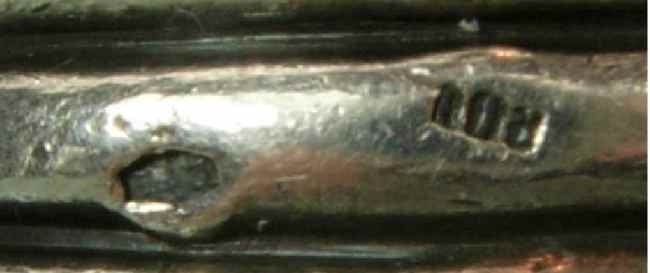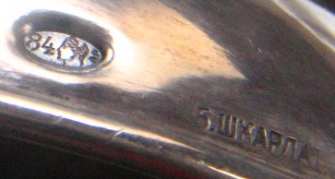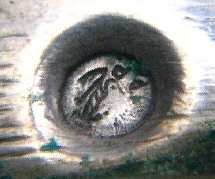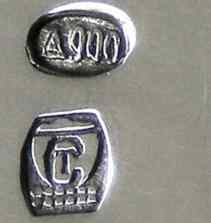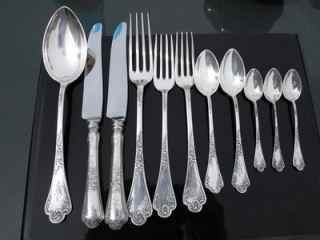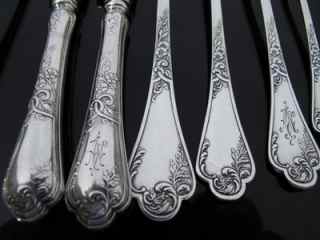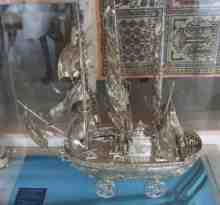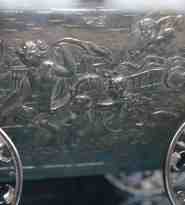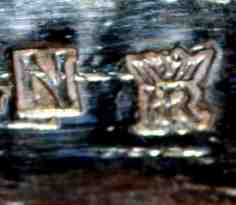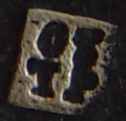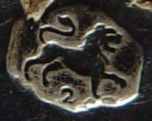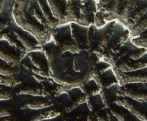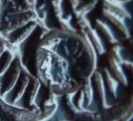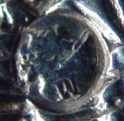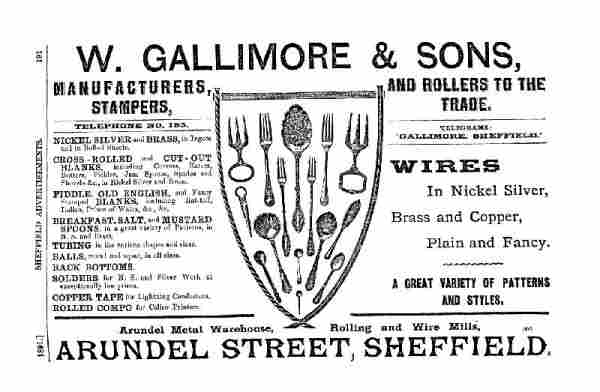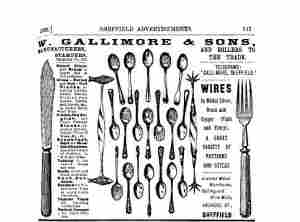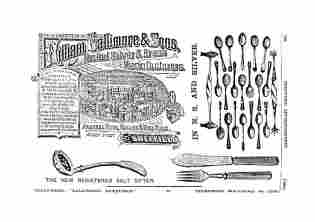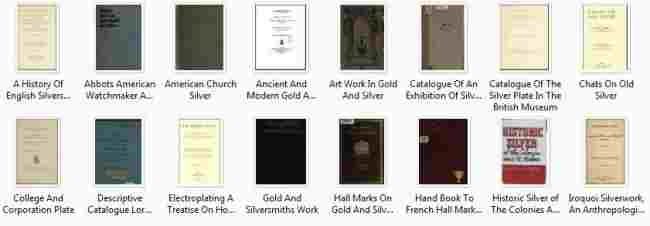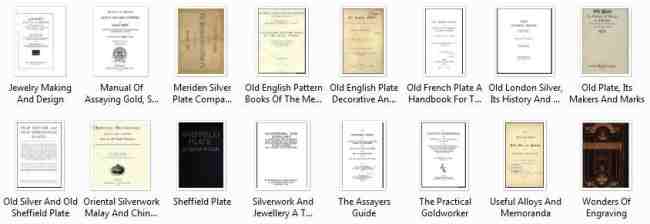 newsletter # 61 JUNE 2009
newsletter # 61 JUNE 2009www.ASCASonline.org SITE MAP
email: silverassociation@yahoo.it
YOUR GUIDE TO JUNE NEWSLETTER:
articles new members
members' window
|
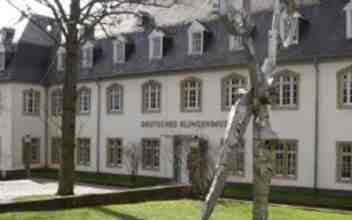
Dorothea Burstyn presents:
click here
|
New members
Welcome to new ASCAS members:
Tony Cranston - Ireland
Charles Deheselle - Belgium
Ilsiya Gloova - Russia
Agus Hartoyo - Indonesia
Brian Kidd - Italy
Jivo Jivkov - Bulgaria
Wayne Lau - Switzerland
Margie Laws Luke - USA
Linda Rowan - USA
Christine Wickizer - USA
|
top page -
page map |
Members' Window # 61
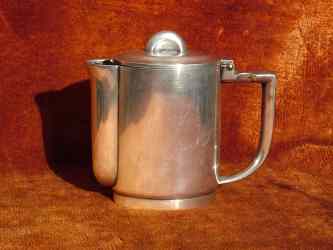
Prof. David N. Nikogosyan presents
|
Mail to ASCAS: e-mail silverassociation@yahoo.it
Sofia Ramos writes:
...I am wondering if your members can help me identify the
purpose of this item (see photos). It is a tray (about 30cm x
24cm) with holders for 2 cups, a burner and a bowl. The seller
thought it might have been used on a ship, hence the need for
the items not to shift around on the tray. The marks show that
it is Portuguese silver, I believe 1886-1938.
It was sold to me as a "port warming set" but I'm not convinced
that this was really the purpose, as port is not generally
heated, at least today, and it's unclear to me how it would have
been done with the silver cups, or what the bowl would have been
for.
Many thanks for any ideas you might have on this!
Regards,
Sofia Ramos
I' have no doubt that this is a silver writing set. This
is what writes Harold Newman in his Dictionary of Silverware:
"Inkstand, a desk stand for writing materials, made in numerous
forms and styles, and supporting a variety of writing
accessories, but the basic forms being as follows
(1) an oblong box, having a hinged lid .......
(2) a tray upon which rests an inkpot, pounce pot, sand-box,
quill-pot and wafer-box .....
On the tray type, the inkpot was sometimes surmounted by a
taperstick for use with the sealing wax.... The tray (triangular,
rectangular, oval or canoe shaped) was sometimes supported by
four small feet and was sometimes fitted with guard-rings or
recesses in which to place the inkpot and pounce-pot, and in the
center the bell or the taperstick; it was sometimes bordered by
a pierced gallery....."
In my opinion an excellent identikit of this piece, but any
other suggestion about its use, date and maker will be welcome.
Giorgio Busetto
Matteo Pierro writes:
...I'm researching information about this cutlery set found in a
WWII German trench on Salerno's battlefield (1943). Each piece
is marked "800", "KNIGHT" and bears a coronet (possibly Earl's)
over a Heraldic shield.
Any suggestion about origin, maker and heraldic provenance of
the set will be highly appreciated.
Matteo Pierro
Bruno Bruni writes:
...I'm trying to identify the maker of this silverplate cutlery
set presented on October 17, 1894 to Masonic Brother Chas
Norrington from the Beadon Lodge 619. The knives are marked on
the blade G H W, S and EP.
Bruno Bruni
I didn't find this silverplate mark. In the hypothesis
that the firm manufactured also sterling silver items I verified
also the hallmarks registered at the Sheffield Assay Office. I
found a quite similar hallmark (GHW into three squares)
corresponding to George Harry Whitaker (later George H. Whitaker
& Co), Pool Square, Fargate, Sheffield, registered on January
24, 1883. As the period of activity of the firm is coherent with
the date that appears on the dedication plate I believe that the
attribution of this piece to Whitaker can be considered probable
Giorgio Busetto
Wayne Robbins writes:
...I have had a wax seal for a number of years which I believe
is made of silver. There are no maker's marks on it, as it is a
very small object. When I purchased it, the seller represented
it as a Russian seal. As you can see in the photos, it is a
triple sided revolving seal and is dated 1856. One side has an
image of a phoenix; the other sides are engraved; however, I
have been unable to determine what the words represent.
You mentioned in the last newsletter that "some ASCAS members
have a deep knowledge of Russian silver". I realize that some
may be knowledgeable as to Russian silver marks -but may not be
able to read Russian. I am hopeful that there may be someone in
our group that may be able to interpret the words. Even if no
one can, perhaps someone could direct me to one who would be
willing to help me do so.
The photos had to be taken in the reflection of a mirror -so as
to read them correctly.
I did take the seal to a Russian lady who could read Russian.
She advised me that it may in fact be Russian, however she felt
it may be what she called "old Russian" and she was not able to
interpret the words.
In any event, I would be most grateful for any help you or other
members may be able to provide.
Sincerely,
Wayne Robbins
Lee Dougall writes:
...I love your site, and have just spent hours on it trying to
find the hallmark of a silver ring I bought recently. I think it
might possibly be Italian; perhaps early February 1934, so that
it had a lozenge 'fascio' mark, but not yet an oval around the
800, but I'm not sure whether this was ever done?
I really hope I'm not imposing, but I wonder if you might have
any idea of the age/origin of the piece.
Both hallmarks are VERY small, and difficult to make out with
the naked eye.
If you did happen to have any thoughts on this that you wouldn't
mind sharing, I would be very grateful to hear them!
Thanks very much for your help.
Kind regards,
Lee Dougall
I confirm. Your item is Italian, made about 1940 (800 was
used with or without oval - see mark #5 at
http://www.silvercollection.it/italianhallmarks.html ).
If you are able to read number and province initials inside the
lozenge I'll try to identify the maker.
Giorgio Busetto
Replies to questions
Diana Hamann receives this reply about her Russian
candlesticks
(see May 2009 Newsletter)
Adam Goldsmith writes:
...Regarding Diana Hamann’s candlesticks, it is to be noted
that assayer Aleksandr Vasilievich Romanov did not start working
at the St. Petersburg assay office until April 1904; before that
he was the assayer in Warsaw, Poland. Although B. Szkarlat has
not been identified, he was definitely working in Warsaw, not
St. Petersburg. He was probably related to and the successor of
Szmul Szkarlat, a noted Warsaw silversmith and maker of Judaica
working in the second half of the 19th century.
Charles C. Cage
Adam Goldsmith writes:
...The candlesticks that Diana Hamann queried are from Warsaw
under Russian rule. The assayer AP was one of two assayers who
worked in the 1896 – 1917 period. Schmuel Sklarat was a well
known Warsaw silversmith especially for candlesticks and other
Judaica related items who worked from 1860 to the very early
1900’s. What is unusual about this marking is that it is in
Cyrillic as the majority of Warsaw silversmiths’ marks are in
English. The style of these candlesticks are typically Polish.
Adam Goldsmith
Cristophe Ginter receives this reply about his mark of
Belgian silversmith
(see May 2009 Newsletter)
Ludo D’Haese writes:
...La marque est celle pour Coosemans Théodore Joseph rue ‘t
Kint 38 à Bruxelles. Périod: 07/01/1942 - ca 1958
Ludo D'Haese
Robert Massart writes:
...The maker's mark Cristophe Ginter was inquiring about in
the latest Ascas newsletter is of Théodore Joseph Coosemans.
This silversmith was active in Brussels and he used the barrel
shaped mark from 7 January 1942 till c.1958.
Kind regards,
Robert
Hugo Keymeulen writes:
The mark T in letter C stands for Théodore Joseph Coosemans.
Worked in Brussels from 07/01/1942 until 1958
The silver mark A900 in an oval stand for A = argent (silver)
and 900 for the purity of 900/1000 silver
Greetings
Hugo Keymeulen
Igor Peremislov receives this reply about his cutlery set
(see May 2009 Newsletter)
Charles C. Cage writes:
...Speaking of Warsaw silver, Igor Peremislov’s flatware has
been identified in the 925-1000 silver forum as a Warsaw set
assembled over the first quarter of the 20th century, by Adam
Nagalski (1862-1944, working from 1894), and with various
markings over the years, including Russian "kokoshnik" marks of
1899-1908 (again with Romanov as assayer), Polish interim marks
of 1915-1920, and Polish state marks of 1920-1931. See this link
for more information:
http://www.925-1000.com/forum/viewtopic.php?t=16053
Charles C. Cage
Adam Goldsmith writes:
...I suspect that the silver cutlery that Igor Peremislov has
is all from Poland from 1896 onwards. Warsaw was under Russian
rule from 1850 to 1920 and they used the same markings as
Russia. That the maker’s mark is in English and not Cyrillic
lettering would support this. I have seen the strange S!84 mark
before and suspect this was the transition mark from Russian to
Polish marks in the early 1920’s. It was also not unusual for a
family to build up a cutlery set over many years.
Adam Goldsmith
Anthony de Goutière receives this reply about his silver nef
(see May 2009 Newsletter)
Charles C. Cage writes:
...Anthony de Goutière’s nef is very typical of the
extravagant silver reproductions made in Hanau, Germany in the
late 19th and early 20th century. The psudo-marks on them have
been attributed to Ludwig Neresheimer & Co. of Hanau, and the
nef is quite typical of their work. You might direct him to
Dorothea Burstyn’s excellent articles on your site:
http://www.ascasonline.org/articolo13.html and
http://www.ascasonline.org/articolox15.html
Charles C. Cage
Rudi Driessen receives this reply about his silver bracelet
(see May 2009 Newsletter)
Charles C. Cage writes:
...You are correct that Rudy Driessen’s bracelet is Dutch,
but I think the date letter is “r” for 1876, not "i" for 1868;
the two letters are very similar. The lion with "2" indicates
the Dutch second silver standard of .833, and the "M" in
Minerva’s helmet (or Perseus’ – the figure has been called both)
was the mark of the assay office in Schoonhoven, active
1837-1984.
The maker’s mark, though, is shown upside-down; it should read
"JL/20". It’s the mark of Schoonhoven manufacturer Jacobus
Johannes Lazonder, working 1857-1880. He was from a large family
of silversmiths including his grandfather Gerrit Lazonder,
father Adrianus Haalbos Lazonder, uncle Johannes Marinus
Lazonder and cousin Gerrit Lazonder.
Charles C. Cage
Hugo Keymeulen writes:
...answer for Rudy Driessen
Lion and 2 stands for standard silver 833/1000
Date letter "I" for 1868
The silversmith is J.J Lazonder worked in Schoonhoven 1857-1880
(the image is reverse and could be JL up 20)
The head towards left stands for the office town. The letter in
the helmet should be M for the town of Schoonhoven
Hugo Keymeulen
"A PAGE per MONTH"
In this column we present a page
obtained from makers' brochures, books, auction catalogs,
advertising or whatever other printed paper related to silver,
which may be of interest for ASCAS members.
The images will be published at a "low resolution" level and for
private and personal use only
This month ASCAS presents a set of advertising published in
the 1890s by W. Gallimore & Sons, Sheffield.
The firm was established in 1822 and William Gallimore started
electroplating in 1858. The firm was active as William Gallimore
& Co in its Arundel Works, Sheffield from 1863 to 1891 when the
style was changed to William Gallimore & Sons (became Ltd in
1923). The firm was still active in 1937.
Besides its production in nickel silver and brass the firm
produced sterling silver items, registering marks at the
Sheffield Assay Office in 1867 (William Gallimore & Co), 1890
and 1892 (Wm Gallimore & Sons).
"A WORD per MONTH"
In this column we presents an abstract
from a page of the "What is? Silver Dictionary"
courtesy of

|
SCOTTISH PROVINCIAL SILVERThe characteristic traits of a people are reflected
in the quality of their art, and so it is with the
history of the early Scotch silversmiths. The austerity
and simple tastes of the Scotchman are brought to notice
by the work of the early craftsmen. The majority of
silver articles made were definitely for practical use,
rather than for purposes of decoration. Most of the
early Scotch silver was used in churches, or else in the
gentle art of drinking.
|
"A BOOK ON MY SHELF"
In this column we present books, new
or ancient, dealing with silver in all its aspects (history,
marks, oddities...). This isn't a "book review" but only a fair
presentation of some useful "tools" that anyone may have in the
shelf of his bookcase.
ASCAS members are invited to contribute to this column
(click to enlarge images)
The "book on my shelf" of this month presents:
30 RARE BOOKS ON ANTIQUE SILVER
Republished For the First Time in an Unique DVD by The Antique Silver Reference Library
Republished For the First Time in an Unique DVD by The Antique Silver Reference Library
The Antique Silver Reference Library uncovers a treasure
trove of antique silver information for collectors, including
many previously unknown hallmarks and silver marks.
Comprised of over 8,700 pages and 30 rare, privately published
and out-of-print reference books, research manuals and museum
works on antique silver and the silversmith trade. Many of these
are being republished here for the first time.
This valuable collection of antique manuscripts has been
meticulously scanned and digitized from original source
documents.
Many of the books were privately printed in the late 1800’s and
early 1900’s and in limited quantities of 175 copies or less for
museums and private collectors, making them virtually impossible
to purchase by the average person. The Antique Silver Reference
Library DVD provides the exact same reference material found in
these rare books, now available for scholars and silver
collectors.
To learn more about this DVD visit
http://www.antiquesilverlibrary.com
* A History Of English Silversmiths, Goldsmiths And
Plateworkers And Their Marks Stamped On Plate (Over 2,500
Illustrations), W. Chaffers, 1899 (300 Pages)
* Abbott’s American Watchmaker And Jeweler, An Encyclopedia For
The Horologist, Jeweler, Gold And Silversmith (Illustrated With
288 Engravings), Henry G. Abbott, 1898 (394 Pages)
* American Church Silver Of The Seventeenth And Eighteenth
Centuries, The Museum Of Fine Arts Boston, 1911 (280 Pages)
* Ancient And Modern Gold And Silversmith’s Work, The South
Kensington Museum, London, 1878 (650 Pages)
* Art Work In Gold And Silver, Henry Wheatley, 1882 (83 Pages)
* Catalogue Of An Exhibition Of Silver Used In New York, New
Jersey And The South, R.T. Haines Halsey, 1911 (193 Pages)
* Catalogue Of The Silver Plate (Greek, Etruscan and Roman) In
The British Museum, H.B. Walters, 1921 (164 Pages)
* Chats On Old Silver, Arthur Hayden, 1917 (432 Pages)
* College And Corporation Silver Plate, Wilfred Joseph Cripps,
1881 (176 Pages)
* Descriptive Catalogue Of The Collection Of Antique Silver
Plate Of Lord Londesborough, Frederick Fairhotl, 1884 (111
Pages)
* Electroplating: A Treatise On How To Do It, William Barclay,
1912 (416 Pages)
* Gold And Silver, John Hungerford Pollen, 1879 (189 Pages)
* Hall Marks On Gold And Silver Plate, W. Chaffers, 1883 (484
Pages)
* Handbook To French Hall Marks On Gold And Silver Plate
(Containing 372 Stamps), Christopher Markham, 1899 (85 Pages)
* Historic Silver Of The Colonies And Its Makers, Francis
Bigelow, 1917 (525 Pages)
* Iroquoi Silverwork, An Anthropological Study Of Their
Handicraft, M.R. Harrington, 1908 (48 Pages)
* Jewelry Making And Design: An Illustrated Textbook For
Teachers, Students Of Design, And Craft Workers In Jewelry,
Augustus Rose, 1917 (527 Pages)
* Manual Of Assaying Gold, Silver, Copper And Lead Ores, Walter
Lee Brown, 1889 (525 Pages)
* Meriden Silver Plate Company Catalogue of 1883, Meriden
Company, 1883 (89 Pages)
* Old English Pattern Books Of The Metals Trade, 1913, (96
Pages)
* Old English Plate Decorative And Domestic (122 Illustrations,
2,500 Plate Marks), Wilfred Cripps, 1894, (484 Pages)
* Old French Plate, A Handbook For The Collector, Wilfred
Cripps, 1880 (149 Pages)
* Old London Silver, Its History, Its Makers And Its Marks,
Montague Howard, 1903 (446 Pages)
* Old Plate, Its Makers And Marks, J. Buck, 1913, (368 Pages)
* Old Silver And Old Sheffield Plate, Howard Okie, 1928 (469
Pages)
* Oriental Silverwork: Malay And Chinese (With Over 250
Illustrations), H. Ling Roth, 1910 (320 Pages)
* Sheffield Plate, Bertie Wyllie, 1920 (242 Pages)
* Silverwork And Jewellery: A Textbook For Students And Workers
In Metal, John Hogg, 1903 (369 Pages)
* The Assayers Guide: Practical Directions To Assayers, Miners,
And Smelters, Oscar Lieber, 1852 (161 Pages)
* The Practical Jewellers Instructor, George Gee, 1877 (310
Pages)
* The Wonders Of Engraving On Silver, Metalwork, Wood And Other
Materials, George Duplessis, 1871 (377 Pages)
* Useful Alloys And Memoranda For Goldsmiths And Jewellers, 1906
(120 Pages)
ASCAS HAS A NEW SITE MAP
ASCAS website offers to its visitors about 300 pages of
articles, information and images about the matter of common
interest. To make easier your website's navigation I'm arranging
an organized SITE MAP classified by subject matter. My
work is still in progress, but the new tool is yet available to
ASCAS readers,
click here.
Your comments and suggestions will be welcome.
Don't forget that ASCAS offers also an internal engine supplied
by google for your researches inside our website
Closing our JUNE 2009 edition of ASCAS Newsletter I hope you have appreciated its content.
Your comments, suggestions and advice will be of great help.
My thanks to Bruno Bruni, Dorothea Burstyn, Charles C. Cage, Ludo D’Haese, Lee Dougall, Jayne Dye, Hugo Keymeulen, Robert Massart, David N. Nikogosyan, Matteo Pierro, Sofia Ramos, Wayne Robbins, for their invaluable contributions.
Giorgio Busetto
Secretary
ASCAS is a community of people having a common
interest in antique silver.
|

